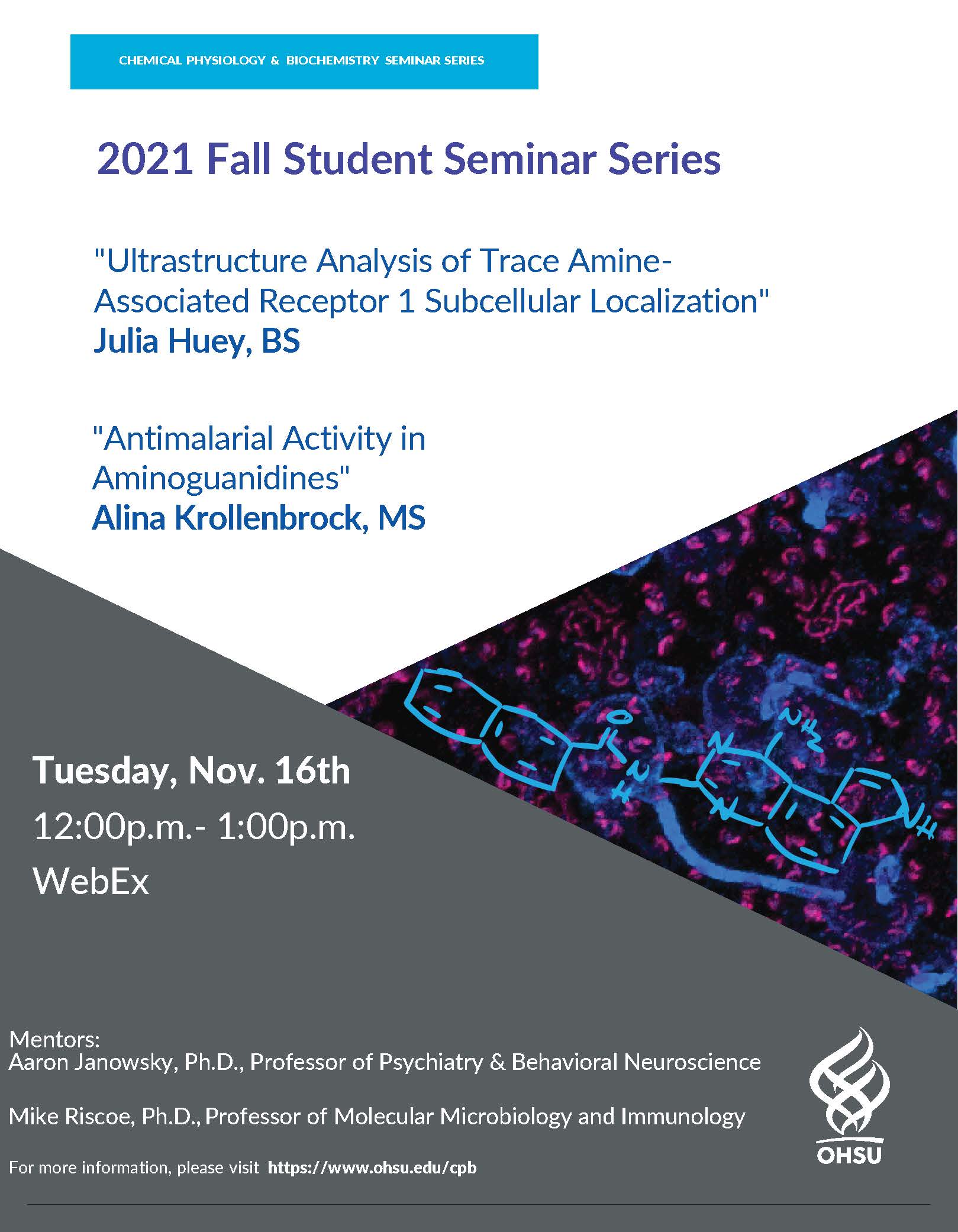CPB 2021 Fall Student Seminar Series
Julia Huey, B.S. & Alina Krollenbrock, M.S.
| When |
November 16, 2021
12 p.m. to 1 p.m.
AbstractsJulia Huey – Janowsky Lab Trace amine-associated receptor 1 (TAAR1) is a G-protein coupled receptor (GPCR) found in monoaminergic neurons of the central nervous system.1 Amphetamine-like psychostimulants activate TAAR1, which couples to Gαs and Gα13 downstream signaling cascades, and the latter regulates the RhoA-mediated internalization of neurotransmitter transporters.2 TAAR1 stimulation is crucial to methamphetamine (MA) mechanism of action, and a common variant of TAAR1 is associated with increased MA craving in MA users.4 Although the impact of TAAR1 on behavior has been characterized, the molecular mechanisms underlying TAAR1 pharmacology are incompletely understood. TAAR1 is a unique GPCR as it resides inside the cell rather than at the cell surface, though the precise location of TAAR1 within the cell is unknown. Understanding the intracellular localization, orientation, and trafficking of TAAR1 will further inform the molecular mechanisms of TAAR1 signaling. However, available antibodies and fluorescent fusion proteins for imaging TAAR1 are inadequate for such studies. Therefore, we have developed a novel method for imaging human (hTAAR1) and mouse (mTAAR1) receptors through both light and electron microscopy using the miniVIPER peptide labeling system for multiscale microscopy.6 The hTAAR1-miniVIPER system has been applied to in vitro systems and has been used in conjunction with light and electron microscopy to explore subcellular localization of the recombinant receptor in Chinese hamster ovary and human endothelial kidney 293 cells (unpublished). Further investigation with electron microscopy will be carried out to determine the orientation of hTAAR1 on internal membranes and will indicate how TAAR1 mobilizes spatially distinct signaling cascades within the cell.2 In order to study the receptor in native brain tissue, AAV constructs will be employed to express mTAAR1-miniVIPER construct in the dopamine neurons of mice. Tissue from these animals will be imaged through fluorescence and electron microscopy to determine the neuronal localization and orientation of TAAR1. Animals expressing mTAAR1-miniVIPER will be subjected to acute and chronic methamphetamine treatments to determine how TAAR1 agonism affects receptor localization and trafficking. Together these studies will expand our current understanding of molecular mechanisms of TAAR1 signaling and will inform future work concerning the role TAAR1 plays in the modulation of neurons involved in neural circuitry relevant to addiction and methamphetamine use disorder. Alina Krollenbrock – Riscoe Lab Despite a long history as an anti-coccidial veterinary drug, the aminoguanidine Robenidine has not been systematically evaluated in the related human pathogen, Plasmodium falciparum. In ongoing doctoral research, a library of aminoguanidine analogues of robenidine was synthesized and evaluated against several strains of blood stage P. falciparum, leading to the discovery of several highly active compounds. Active analogues were further evaluated in vivo in a murine malaria model, resulting in ED50 values as low as 0.25 mg/kg/day in a standard 4-day test. Continuing studies of the aminoguanidine chemotype include the synthesis of more complex compounds, evaluation against other human pathogens, and chemical exploration of mechanism of action. 
Lisa Gurung
|
|---|---|
| Where |
WebEx |
| Contact Information |
Lisa Gurung
|
Abstracts
Julia Huey – Janowsky Lab
Trace amine-associated receptor 1 (TAAR1) is a G-protein coupled receptor (GPCR) found in monoaminergic neurons of the central nervous system.1 Amphetamine-like psychostimulants activate TAAR1, which couples to Gαs and Gα13 downstream signaling cascades, and the latter regulates the RhoA-mediated internalization of neurotransmitter transporters.2 TAAR1 stimulation is crucial to methamphetamine (MA) mechanism of action, and a common variant of TAAR1 is associated with increased MA craving in MA users.4 Although the impact of TAAR1 on behavior has been characterized, the molecular mechanisms underlying TAAR1 pharmacology are incompletely understood. TAAR1 is a unique GPCR as it resides inside the cell rather than at the cell surface, though the precise location of TAAR1 within the cell is unknown. Understanding the intracellular localization, orientation, and trafficking of TAAR1 will further inform the molecular mechanisms of TAAR1 signaling. However, available antibodies and fluorescent fusion proteins for imaging TAAR1 are inadequate for such studies. Therefore, we have developed a novel method for imaging human (hTAAR1) and mouse (mTAAR1) receptors through both light and electron microscopy using the miniVIPER peptide labeling system for multiscale microscopy.6 The hTAAR1-miniVIPER system has been applied to in vitro systems and has been used in conjunction with light and electron microscopy to explore subcellular localization of the recombinant receptor in Chinese hamster ovary and human endothelial kidney 293 cells (unpublished). Further investigation with electron microscopy will be carried out to determine the orientation of hTAAR1 on internal membranes and will indicate how TAAR1 mobilizes spatially distinct signaling cascades within the cell.2 In order to study the receptor in native brain tissue, AAV constructs will be employed to express mTAAR1-miniVIPER construct in the dopamine neurons of mice. Tissue from these animals will be imaged through fluorescence and electron microscopy to determine the neuronal localization and orientation of TAAR1. Animals expressing mTAAR1-miniVIPER will be subjected to acute and chronic methamphetamine treatments to determine how TAAR1 agonism affects receptor localization and trafficking. Together these studies will expand our current understanding of molecular mechanisms of TAAR1 signaling and will inform future work concerning the role TAAR1 plays in the modulation of neurons involved in neural circuitry relevant to addiction and methamphetamine use disorder.
Alina Krollenbrock – Riscoe Lab
Despite a long history as an anti-coccidial veterinary drug, the aminoguanidine Robenidine has not been systematically evaluated in the related human pathogen, Plasmodium falciparum. In ongoing doctoral research, a library of aminoguanidine analogues of robenidine was synthesized and evaluated against several strains of blood stage P. falciparum, leading to the discovery of several highly active compounds. Active analogues were further evaluated in vivo in a murine malaria model, resulting in ED50 values as low as 0.25 mg/kg/day in a standard 4-day test. Continuing studies of the aminoguanidine chemotype include the synthesis of more complex compounds, evaluation against other human pathogens, and chemical exploration of mechanism of action.
